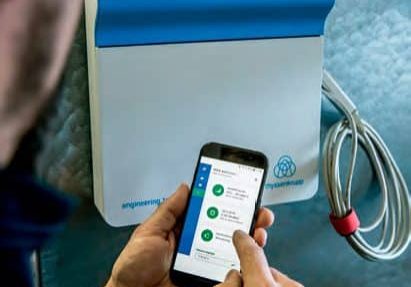Elevator Door Detector Light Curtains and Related Door-Closing Injuries
Jun 1, 2020
An increase in incidents prompts this examination and explanation of door protection devices.
by Frank Fletcher, Jill Sweeney and Michael Fagan
We have observed a trend in personal injuries and the litigation-support business regarding elevator noncontact, infrared door detectors, aka “door detectors.” These devices were introduced in the early 1990s and instantly recognized by owners and contractors as valuable and important upgrades to passenger elevators. These passenger-safety door protection devices project a 2D array of infrared sensor beams across the full width and height of the elevator door entrance threshold and pathway. The elevator door will automatically reopen when the sensor beams are obstructed by an object in the path of the closing door. This occurs without physical contact by the person or object obstructing the pathway of the car door. Injuries still occur, however, because of assumed protection and learned behavior.
2D Successes
The success of these door protection devices is confirmed by their industry acceptance and reduction of door-related injuries to passengers. A person, when hurrying to catch an elevator, will frequently project a hand or foot into the path of the closing door to make the doors reopen when entering the elevator. Passengers expect this behavior to work every time.
This learned behavioral practice by passengers can be traced back to when elevator car doors were only equipped with a mechanically operated “safety edge” to reopen the elevator doors. Subsequently, this became a common practice by the public as a means of causing the doors to reopen when entering the elevator. The behavior began when automatic elevators showed up in the U.S. in the 1950s and 1960s. The “safety edge” required the door edge to be retracted by physical contact with an object or person, causing a microswitch to be activated to open the door. This configuration was supplemented by the placement of two electric eye beams, also on the car door panel for noncontact and generally on the door at 5 and 32 in., for the same purpose.
Old Technology and Door Strike Accidents
We occasionally still encounter “safety edges” on older elevator doors. By our estimation, a small percentage of the passenger elevators in use today employ them. They are usually found in older buildings, where they employ relay logic controls.
The amazing reliability of newer 2D door detector devices has created a unique problem for those responsible for elevator operations, as well as the riding public. The problem is that these devices do not detect an object in the door pathway until a passenger attempting to board the elevator reaches several inches past the hall door and into the path of the closing car door. By considering door thickness and running clearances, and the hall door system, this gap can be as much as 6 in.
Door Systems & Operation
There are two doors in an elevator system: the car door that travels with the elevator car and the hoistway door. When the elevator car arrives at a landing, the car door mechanically engages and unlocks the hoistway door. The door detector infrared light curtain is attached to the car door and travels with the elevator. If the door detector should fail, it will default to a safe state and prevent the doors from closing until remedial action is taken by a technician. Typically, if it fails, after 15-20 s, the doors are allowed to close on “nudging” operation, with a sound annunciating the door detector being rendered inoperative as the doors close at a reduced speed.
There needs to be a consideration by the field personnel, management and companies to assess the risks related to the door speed closing time of each elevator installation.
3D has been around for 20 years, but recent improvements and cost reductions have generated new code requirements to provide it on all new elevators in the 2019 edition of the ASME A17.1/CSA B44 Safety Code for Elevators and Escalators.
On some elevators, a person’s hand or foot would have to project 4-7 in. past the leading edge of the hoistway door to interrupt the door detector beams and activate the controls to reopen the door (Figure 1). We have encountered several injuries in which a person’s hands or feet, which had not yet projected into the entrance to reach the car door sensors to break the beams, were injured by the hoistway doors closing.
The increased passenger safety created by the 2D detector may be defeated if the closing speed of the car door is too fast for the conditions it operates under, such as hospitals, elderly care facilities, casinos and other areas where people are impaired or distracted, and other unique elevator environments and installations. There needs to be a consideration by the field personnel, management and companies to assess the risks related to the door speed closing time of each elevator installation. It may remain possible that a boarding passenger may enter the path of the closing elevator door before the 2D detector can physically reverse the direction and the door. The car door may still strike the person with the full force and inertia of the doors, causing injury.
Code requires that elevator doors should be set to no greater a closing force than 30 lb in the center third of the door travel. Most are well within that limit, but one problem usually occurs in the last few inches of the closing cycle. To ensure the electrical connections of the elevator circuits are made properly to let the elevator run, the last couple of inches of door travel have unlimited door closing force to “squeeze” the doors together to ensure the door interlock mechanically locks and electrically closes the “safety string.” If the closing doors do not properly complete the circuits at this point, the controller sees the door as open, and the elevator fails to run. This creates an increased risk for the owner and the elevator company and a hazard in the operation of the elevator for the public.
What Is Better Than a 2D Door Detector?
Innovation and technology have recently addressed this problem, along with some new code requirements, by providing door detectors that employ sensors allowing for 3D scanning of the elevator entrance as the door closes. 3D has been around for 20 years, but recent improvements and cost reductions have generated new code requirements to provide it on all new elevators in the 2019 edition of the ASME A17.1/CSA B44 Safety Code for Elevators and Escalators.
These new-generation 3D edges look for moving targets in front of the hoistway doors and entrance areas, and sense when an object or person is approaching the elevator. Additionally, some manufacturers provide 2D door detectors with flashing colored LEDs on the leading edge of the car door detector. These
flashing lights are red or yellow for closing, and green for opening (Figure 2). This visually alerts passengers when the doors are in the opening or closing cycle, and offers additional passenger protection from them.
When an elevator door is equipped with a 3D door detector, a person using a cane or wheelchair does not have to rush to get in the path of the closing car doors to cause them to reopen. The 3D sensors will project their scan outward to detect a person or cart as they approach the elevator to board the car. This feature avoids the perceived need and risks associated with sticking a hand or a foot into the pathway of the car door to reverse the closing. Additionally, the 3D feature can also detect, for example, a delivery driver pushing a cart into the doorway and causing damage to the hall and car doors. Keep in mind that 2D, in addition to 3D, protection is still required.
There have been severe and expensive injuries and subsequent litigation costs incurred resulting from passengers placing body parts in front of the closing car doors. This premature closing can be prevented by the 3D door detector installation. Normally, 3D detector cost and installation are analogous to those of older 2D light-curtain models.
The victims of the success of the detectors are manufacturers of the older 2D devices and building owners brought into door-related personal injury lawsuits for claims that are rooted in an archaic and learned public behavior. Given the advancing age of the U.S. population, we will be seeing more and more door strike injuries and lawsuits. We regularly recommend the 2D devices with infrared sensors be supplemented with new 3D models.
We have also seen elevators with installed 3D devices with the 3D feature turned off by the service mechanic to stop random service calls due to sunlight and other conditions that affect the operation of older detectors. When the 3D feature is part of the edge design, it only needs to be turned on and properly adjusted. Many of the issues in early 3D devices are now history.
Property managers can make a simple determination if this elevator door control feature is present on their elevator by standing in front of the hoistway doors for a moment while the doors are fully open and not obstructing the car-door 2D device. Then, they wait until the doors start to close. No further action is needed if the audible nudging door-closing signal occurs or if the doors remain open. If the doors start to close and the 2D car-door device is not obstructed, contact the service mechanic and inquire if the 3D feature is available, can be activated, or if there is a reason it is turned off.
Conclusion
Hopefully, as the 3D detector with the ability of side scanning of the entrance frames gains popularity, these new 3D detectors will be able to see a person in time to prevent and eliminate the types of door strike injuries explained here and offset the public behavior of trying to intercept the closing doors with their hands or feet to reopen them.
Future passengers will be the beneficiaries of new protections in line with past learned behavior. During the transition to this full 3D protection, passengers must be made aware that the location of the 2D detector device is on the car door and that the unprotected hoistway door will continue to be a risk when boarding an elevator. Building owners and representatives should consider requesting 3D upgrades from their elevator maintenance providers as a part of their risk-management programs.
Get more of Elevator World. Sign up for our free e-newsletter.







